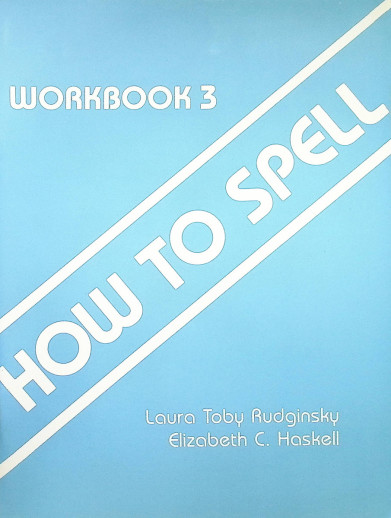We use cookies to make your experience better. To comply with the new e-Privacy directive, we need to ask for your consent to set the cookies. Learn more.
How to Spell 3
Worktexts contain all the phonograms, spelling rules and generalizations to be covered in that level (corresponding to lessons in the manual), space for copying and dictation, and exercises appropriate for that grade level. Each level contains three Sound Sheets, containing phonograms for memorization. It's like a little phonics course or review in preparation for the lessons.
Best for Grades 4 to 6, How to Spell 3 workbook includes three “sound sheets” that outline and explain important sound patterns. Each page includes clear, precise instructions. Students will learn to spell by pronouncing and writing words and reinforce what they have learned by working individually in the workbook or through the How to Teach Spelling Resource Manual. Skills addressed include soft c and g, syllable types, syllabication, sight words, affixes and roots, spelling generalizations (k-ck, ch-tch, ge-dge, ou-ow, au-aw), silent letters, plurals, contractions, doubling rule, silent-e rule, y rule, i before e generalization, digraphs, diphthongs, and word endings.
How to Teach Spelling is an excellent program for helping students learn to recognize the sounds in the English language, to decode words, and to spell words correctly by relying on spelling rules and patterns rather than on memory.
PRODUCT FEATURES- How to Spell 3 workbook helps Grade 4 to 6 students learn how to spell by saying and copying words, sounds, sight words, and new rules such as doubling, silent -e , and pluralization
- Most lessons include reading the sound and key word, which students will memorize before moving on to additional words with the same sound
- Students will also say words aloud to help with reinforcement
- Workbook also includes a chart for students to measure their progress as they learn more sounds and spelling patterns
- How to Spell workbooks and resources can be used in the classroom, with a small group, or with an individual student
This is a wonderful, comprehensive spelling program, based on the Orton-Gillingham approach to reading and spelling. It presents a systematic, phonetic method of teaching and learning spelling, believing all students should: recognize the sounds in the English language; be able to decode words; and spell words correctly by relying on spelling rules and generalizations rather than memory. It is a structured, graded program that uses an incremental approach, reviewing previously-learned rules as students progress through the workbooks. Sight words are introduced at intervals and incorporated into the dictation. How to Teach Spelling is the manual for the entire program (and required for its use). It explains the philosophy, methods, and presentation of lessons by spelling rule, specifying grade level for which it is taught. It also contains all of the lessons, including dictation words and sentences. You will need to get familiar with this guidebook before you begin the program, but lessons themselves require little to no preparation. Worktexts contain all the phonograms, spelling rules and generalizations to be covered in that level (corresponding to lessons in the manual), space for copying and dictation, and exercises appropriate for that grade level. Each level contains three Sound Sheets, containing phonograms for memorization. It's like a little phonics course or review in preparation for the lessons. The program refers to the use of Phonics Drill Cards in presenting these phonograms. These are rather expensive, and you can construct your own using information in How To Teach Spelling. We have included them, however, below. How to Spell 1 includes exercise instructions for the teacher on each page. Other levels have a separate Teacher's Key with answers. All previously taught spelling rules are reviewed in later worktexts, so if you have a student needing remedial work in spelling, just begin at her grade level worktext. This is an excellent program for remedial spelling. It is one of the few programs that teaches and reviews all phonograms and spelling rules at upper grades.
| Product Format: | Softcover Book |
|---|---|
| Grades: | 4-6 |
| Brand: | Educators Publishing Service |
| Author: | Laura Toby Rudginsky |
| ISBN: | 9780838818527 |
| Length in Inches: | 11 |
| Width in Inches: | 8.5 |
| Height in Inches: | 0.25 |
| Weight in Pounds: | 0.5 |
| Publication Date: | 1/3/2013 |


It is a good resource that I have used before teaching the patterns and rules of spelling at the more advanced level.
I have the overview book.
I have the How To Teach Spelling book from this series and wanted the pre-made workbooks to work within that same structure.
Great spelling program that's clear and concise but still uses the orton gillingham method. Is more user friendly that writing road to reading and all about spelling